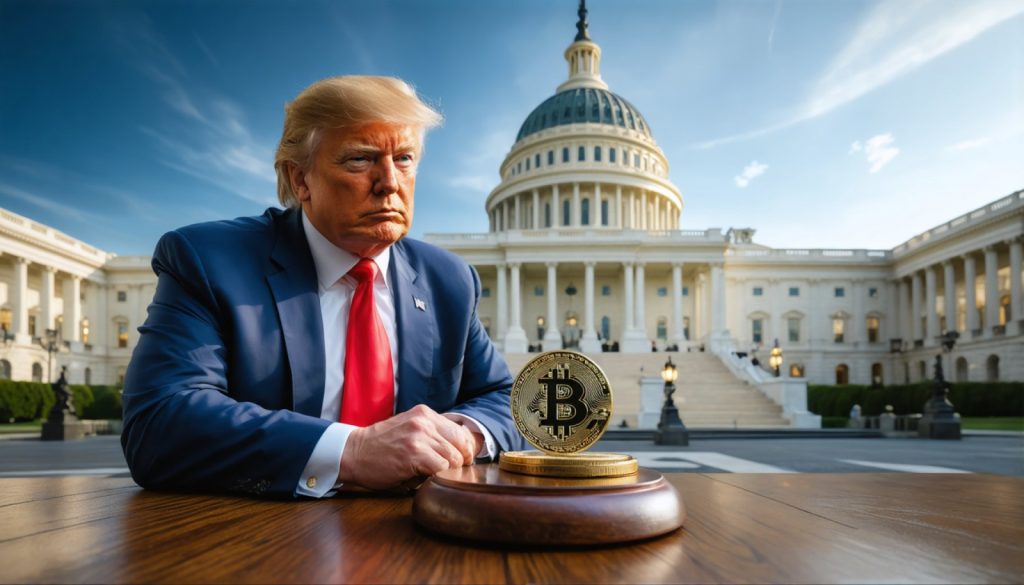
- U.S. Congress is reviewing a new stablecoin bill, aiming to establish regulatory guidelines for digital currencies.
- The USD1 stablecoin, launched by the Trump-aligned WLFI, creates debate due to its political connections and potential regulatory risks.
- Lawmakers express concerns about politically-linked stablecoins undermining financial stability and regulatory oversight.
- The House Financial Services Committee emphasizes the need for federal governance to prevent vulnerabilities in financial systems.
- Binance complies with EU’s MiCA regulations by delisting Tether (USDT) in the European market, indicating global regulatory impact.
- Despite regulatory challenges, the stablecoin market remains resilient with a steady $238 billion market cap.
- The ongoing legislative developments highlight the balance between innovation and regulation in the crypto world.
In a landmark moment for the crypto world, the U.S. Congress has embarked on the meticulous task of parsing a new stablecoin bill, intending to lay down regulatory groundwork in the ever-evolving digital landscape. This review comes on the heels of a notable move by the Trump-aligned Web3 Liberty Financial Initiative (WLFI), which has unveiled its USD1 stablecoin, meticulously pegged to the U.S. dollar.
The USD1 stablecoin, launched with considerable fanfare, finds its political ties intriguing yet contentious. The connection stirs a debate about the potential perils of merging economic instruments with political alliances. Lawmakers, particularly those from the Democratic side, express unease over the implications of a digital currency with such entanglements, fearing it might undermine financial norms and evade regulatory grasp, all while being wielded as a tool for unforeseen political gain due to the leniencies that might accompany a former president.
In the chamber of the House Financial Services Committee, voices of caution echoed. The prospect of a politically-tinged stablecoin infiltrating mainstream financial systems is a concept fraught with challenges, commentators warn. They argue that without robust federal governance, digital tokens, like USD1, could germinate vulnerabilities within the financial infrastructure, or worse, serve as conduits for unsavory political agendas masked behind the allure of digital innovation.
As Congress advances the bill through its legislative course, the crypto community watches with bated breath. The debate promises to sharpen its focus on critical issues – from the need for heightened transparency and compliance to understanding how digital currencies might intertwine with political dynamics.
Amid this backdrop, Binance, a titan in the crypto exchange arena, nods to regulatory whispers by axing Tether (USDT), a popular stablecoin, from the European Union marketplace. This maneuver aligns with the stringent requirements of the newly-enacted Markets in Crypto-Assets (MiCA) regulation, showcasing a ripple effect of compliance across the globe.
Despite these regulatory tremors, the stablecoin market presents a picture of calm continuity. The latest datelines from Coingecko reveal a stablecoin market cap holding firm at $238 billion, ticking up by a slight 0.1% — a testament to the market’s resilience and a hint of the intense scrutiny stablecoins will continue to garner in the dynamic arena of global finance.
As the storyline of stablecoins unfolds on the legislative stage, it reminds stakeholders and onlookers alike of the intricate dance between innovation and regulation. In this dance, the challenge lies in crafting policies that safeguard economic stability without stifling the creativity that drives technological progress.
The Future of Stablecoins: Regulatory Challenges and Opportunities
Background and Context
In a pivotal development in the cryptocurrency sector, U.S. Congress is evaluating a new stablecoin bill to establish regulatory frameworks amid rapid technological advancements. Concurrently, the Trump-linked Web3 Liberty Financial Initiative (WLFI) has introduced the USD1 stablecoin, pegged to the U.S. dollar, igniting debate over stablecoins intersecting with political landscapes.
Additional Insights on the Stablecoin Market
Market Forecast & Industry Trends
Despite the regulatory discussions and concerns, stablecoins remain a steady force in the crypto market, with a current market cap of approximately $238 billion as of recent Coingecko reports. This sector’s growth trajectory suggests potential expansion as digital asset adoption increases in both retail and institutional spaces. According to a report by Deloitte, stablecoins could enhance financial transactions’ efficiency, reducing costs and improving cross-border transfer speeds.
Regulatory and Security Concerns
Regulators express concern over stablecoins’ potential to disrupt traditional financial systems, exemplified by the USD1 coin’s politically charged origin. There are apprehensions about these digital assets being used for political gains or circumventing financial norms. Effective regulation is vital, as highlighted by global regulatory actions, such as Binance withdrawing Tether (USDT) from the EU market to comply with the Markets in Crypto-Assets (MiCA) regulation.
Use Case Scenarios
The integration of stablecoins in mainstream finance poses significant opportunities for innovation:
1. Cross-border Payments: Stablecoins can facilitate quicker, cost-effective international money transfers, providing alternatives to traditional banking systems.
2. Remittances: With lower transaction fees compared to conventional remittance services, stablecoins offer a viable solution for migrant workers sending money home.
3. Decentralized Finance: Stablecoins act as a cornerstone within the DeFi ecosystem, offering stability in an otherwise volatile market.
Controversies and Limitations
The interplay between stablecoins and political influence raises vital questions about autonomy and control over digital currencies. Critics argue that politically entangled stablecoins might prioritize agenda-driven objectives over financial inclusivity and democratization.
Furthermore, without a unified global regulatory framework, fragmented approaches could lead to compliance challenges and potential market instability.
Pros and Cons Overview
Pros:
– Enhanced financial inclusion and accessibility
– Reduced transaction costs and processing times
– Stability in a volatile crypto market
Cons:
– Regulatory uncertainties and compliance hurdles
– Potential misuse for political or unethical purposes
– Risk to traditional banking systems
Recommendations and Quick Tips
– For Investors: Diversify your portfolio with stablecoins for balance and liquidity.
– For Policymakers: Engage with both technology and financial experts to craft regulations that support innovation while ensuring security.
– For Businesses: Explore stablecoin integration for payments to streamline operations and cut costs.
Conclusion
As regulatory spotlights intensify, the stablecoin sector must negotiate its path carefully amid opportunities and challenges. Building robust regulations that balance innovation and economic stability is essential for sustainable growth.
For more on cryptocurrency trends and insights, visit CoinDesk.



